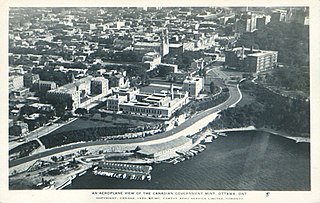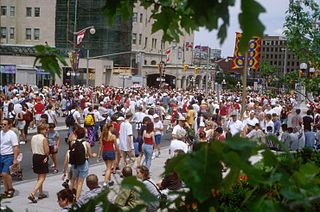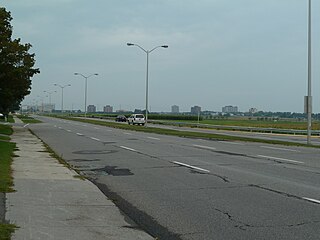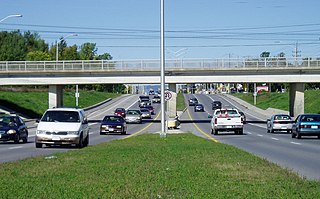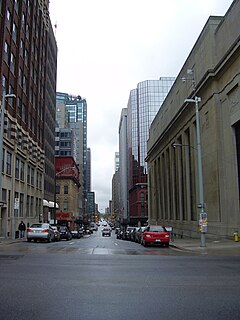


Bronson Avenue ( Ottawa Road #79) is a major north-south arterial road in Ottawa, Ontario, Canada. It starts as a continuation of the Airport Parkway, which is an expressway to the Macdonald-Cartier International Airport. It continues past Carleton University, the Glebe, north through Centretown, and ends downtown at Sparks Street.

Ottawa is the capital city of Canada. It stands on the south bank of the Ottawa River in the eastern portion of southern Ontario. Ottawa borders Gatineau, Quebec; the two form the core of the Ottawa–Gatineau census metropolitan area (CMA) and the National Capital Region (NCR). As of 2016, Ottawa had a city population of 964,743 and a metropolitan population of 1,323,783 making it the fourth-largest city and the fifth-largest CMA in Canada.

Ontario is one of the 13 provinces and territories of Canada and is located in east-central Canada. It is Canada's most populous province accounting for 38.3 percent of the country's population, and is the second-largest province in total area. Ontario is fourth-largest jurisdiction in total area when the territories of the Northwest Territories and Nunavut are included. It is home to the nation's capital city, Ottawa, and the nation's most populous city, Toronto, which is also Ontario's provincial capital.

Canada is a country in the northern part of North America. Its ten provinces and three territories extend from the Atlantic to the Pacific and northward into the Arctic Ocean, covering 9.98 million square kilometres, making it the world's second-largest country by total area. Canada's southern border with the United States is the world's longest bi-national land border. Its capital is Ottawa, and its three largest metropolitan areas are Toronto, Montreal, and Vancouver. As a whole, Canada is sparsely populated, the majority of its land area being dominated by forest and tundra. Consequently, its population is highly urbanized, with over 80 percent of its inhabitants concentrated in large and medium-sized cities, many near the southern border. Canada's climate varies widely across its vast area, ranging from arctic weather in the north, to hot summers in the southern regions, with four distinct seasons.
Contents
Starting as an expressway leading from the Airport Parkway, Bronson quickly becomes a six lane divided principal arterial with little or no direct frontage and a speed limit of 70 km/h (43 mph). From Colonel By Drive, Bronson Avenue continues as a four-lane undivided principal arterial road through residential and commercial areas with a speed limit of 50 km/h (31 mph). Upon reaching Albert Street, Bronson ends as a local road for downtown residents.

A limited-access road, known by various terms worldwide, including limited-access highway, dual-carriageway, expressway, and partial controlled access highway, is a highway or arterial road for high-speed traffic which has many or most characteristics of a controlled-access highway, including limited or no access to adjacent property, some degree of separation of opposing traffic flow, use of grade separated interchanges to some extent, prohibition of some modes of transport such as bicycles or horses, and very few or no intersecting cross-streets. The degree of isolation from local traffic allowed varies between countries and regions. The precise definition of these terms varies by jurisdiction.
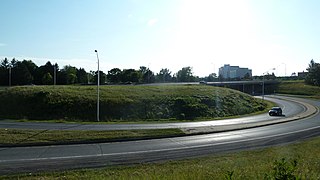
Airport Parkway is an expressway in Ottawa, Ontario, Canada. It runs from the Ottawa Macdonald-Cartier International Airport to an interchange with Heron Road where it turns into Bronson Avenue.
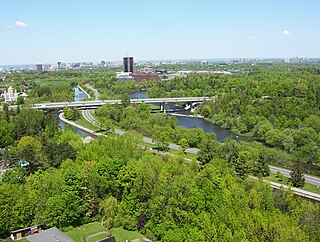
Colonel By Drive is an 8.1 km (5.0 mi) long scenic parkway in Ottawa, Ontario, Canada named after Colonel John By. It runs along the Rideau Canal from the end of Sussex Drive at Rideau Street. It then continues 8 km (5.0 mi) south and west to Hog's Back Road, winding through several residential areas and going past Dow's Lake and Carleton University. To the north, the road passes Department of National Defence Headquarters, the Ottawa Congress Centre and the Westin Hotel before ending at Wellington Street and Rideau Street. The rear door of the Government Conference Centre can be accessed from the street as well, after it passes under the Mackenzie King Bridge. It is named for Lieutenant-Colonel John By, who built the Rideau Canal. The winding two-lane road has a speed limit of 60 km/h (37 mph).
Bronson Avenue is a gateway to the southern neighborhoods of Ottawa and since it is generally faster to take Bronson Avenue than Bank Street, the street is usually quite busy, particularly at rush hour.

Bank Street is the major north-south road in Ottawa, Ontario, Canada. It runs south from Wellington Street in downtown Ottawa, south through the neighbourhoods of Centretown, The Glebe, Old Ottawa South, Alta Vista, Hunt Club, and then through the villages of Blossom Park, Leitrim, South Gloucester, Greely, Metcalfe, Spring Hill, and Vernon before exiting the city limits at Belmeade Road.

A rush hour or peak hour is a part of the day during which traffic congestion on roads and crowding on public transport is at its highest. Normally, this happens twice every weekday; once in the morning and once in the afternoon or evening, the times during which the most people commute. The term is often used for a period of peak congestion that may last for more than one hour.
Glebe Collegiate Institute and Carleton University border on Bronson Avenue.
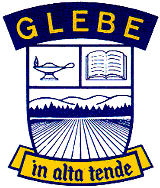
Glebe Collegiate Institute (GCI) is a high school in the Glebe neighbourhood of Ottawa, Ontario, Canada. Administered by the Ottawa-Carleton District School Board (OCDSB), Glebe Collegiate Institute has approximately 1,700 students. Glebe CI is the district's largest school.

Carleton University is a public comprehensive university in Ottawa, Ontario, Canada. Founded in 1942 as Carleton College, a private, non-denominational evening college to serve veterans returning from World War II, the institution was chartered as a university by the provincial government in 1952 through the The Carleton University Act. The legislation was subsequently amended in 1957 to give the institution to its current name. The university moved to its current campus in 1959, and would expand rapidly throughout the 1960s amid broader efforts by the provincial government to increase support to post-secondary institutions and expand access to higher education.
There has been considerable debate about the nature of the road in the past few years; some have called for an expressway to be built in the corridor to link to a twinned Airport Parkway; but that has been extremely unpopular with local residents calling for improved public transit and is unlikely to be built.
Bronson Avenue took its name from Ottawa businessman and politician (Ontario MLA) Erskine Henry Bronson. [1]

Erskine Henry Bronson was an American-born Canadian businessman and political figure. He represented the riding of Ottawa in the Legislative Assembly of Ontario from 1886 to 1898.




